- Offensive Techniques & Strategies
Player Safety & Injury Prevention
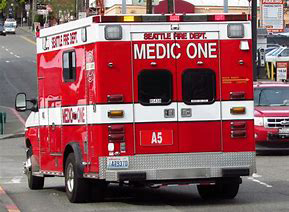
Medical Emergencies
What you will discover or recall:
Realize the magnitude of a medical emergency.
Understand the vital importance and responsibility of having an “Automatic Emergency Response” system in place in the event of a medical emergency.
Comprehend the magnitude and responsibility of recognizing the signs and symptoms of Concussions.
In the case of head, neck or back injuries, realize the importance of immobilizing and NOT moving a victim.
Learn to be cognizant of Heat Exhaustion, and life threatening Heat Stroke.| Emergency Calls | Sudden Cardio Death | Action Plan | AED's | Concussions | Heat Exhaustion & Stroke |

9-1-1 Emergency Calls
Be sure to follow these six steps in making an emergency phone calls.
1. Give your name and call back number.
2. State that you have a medical emergency.
3. Provide and describe the nature of the injury.
4. Be prepared to provide address and nearest cross streets.
5. Give exact location such as basketball court in main gym.
lastly, Do not hang up until the other party hangs up.

Sudden Cardio Death

Sudden Cardio Death is the number one cause of death among athletes. However, with the proper preparation and response, the chances of a player's survival is great. Organizing and having an automated response system in place is critical.
Magnitude
Recently, a high school player received national media attention when he died after making a game winning shot. This did not only sent shock waves throughout the basketball world, but brought out the concerns of the hidden health dangers faced by young athletes and the importance of coaches being prepared for on the court life threatening emergencies. In that same week, four other basketball related sudden cardio deaths occurred.
In the United States over a 100 sudden cardio deaths occur annually among middle school, high school and college athletes with basketball having the highest risk. That is one every three days. The risk of sudden cardiac death among NCAA Division I male players is 1 in 3,000. The most common cause of sudden cardio related deaths among young athletes is hypertrophic cardiomyopathy a thickening of the heart muscle. This abnormal growth which goes undetected in most cases can cause cardiac arrest during exertion particularly in young African-American players where the risk is 3X greater than Caucasian players. The risk of sudden cardio death is also 3X greater in males than females.
Sudden Cardio Death Survival
The good news is, if CPR is started and defibrillation applied within the first few minutes of sudden cardio death, the chances of survival are great. Automatic External Defibrillator (AED’s) are now required by law in public malls, airports, and casinos. However, 30 states still do not require them in schools. Fortunately, administrators, foundations and communities are realizing the real need for AED’s and providing a growing number of schools with AED’s. Make sure your school or venue has one available. Proper use of an Automatic External Defibrillator (AED) is relatively simple matter and only takes a few minutes to learn. AED’s are practically “dummy” proof. They will only automatically fire (shock) if it is warranted. Note: Coaches’ accessibility after school hours can be a problem that needs to be address.
Screening & Prevention
Since athletic training and competition increases the risk of sudden cardiac death in players with underlying heart disease, the American Heart Association, highly recommends that student/athletes be screened with a careful history, including family history and through physical examination including EKG’s and Echocardiograms. However, testing and screening will not detect all causes of sudden cardio death. Currently, 80% occur with no warning or previous symptoms including family history. Therefore, all coaches must be prepared. This means not only being CPR trained, but also having a plan of action in place.

“Anyone can save a life” Response Model

Note: This emergency response model is applicable to all basketball programs on all levels, youth through professional, not just high schools. If you are conducting a basketball program on any level, it is your responsibility to have an automated response system in place in the event of an emergency.
Minnesota State High School Athletic Association has organized a terrific plan to respond to sudden cardiac emergencies. The program named “Anyone Can Save a Life,” empowers coaches to organize their teams into action in the event of an emergency. It requires coaches to spend 10 minutes at the beginning of each team’s season asking questions of his/her team as to how many have been trained in CPR and would they be willing to assist in the event of an emergency if needed? From this dialog, players are then assigned emergency roles. This creates an automatic response system which allows the coach to remain with the victim without having to give direction.
Automated Response System:
1. At least two players are assigned to call 911.
2. At least two players are assigned to run to the athletic trainer’s office.
3. Two players are assigned to know where the nearest AED device is and to go retrieve it.
4. Other players are assigned to go to a predetermined location to meet the medics or an ambulance.
After those assignments have been made, the coach fills out a worksheet, which is kept on record in the school’s athletic office. Each team is required to review the assignments periodically during the season.
 Printable Medical Emergency Response Assignment Form
Printable Medical Emergency Response Assignment FormWhile this may seem like just one more thing to add to a coach’s workload, most coaches understand the importance of having a plan and a course of action in place. The chances of a positive and successful outcome in the event of an emergency, far outweighs the added responsibility of a coach of having one more thing to do.

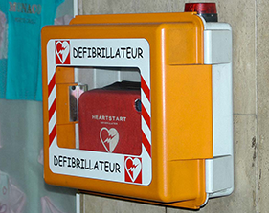
Automatic External Defibrillators
Automatic External Defibrillator or AED’s, are now required by law in public malls, airports, and casinos. However, 30 states still do not require them in schools. Fortunately, administrators, foundations and communities are realizing the real need for AED’s and providing a growing number of schools with AED’s. Make sure your school or venue has one available and know it's location.
Proper use of an Automatic External Defibrillator, AED, is a relatively simple matter and only takes a few minutes to learn. AED’s are practically dummy proof. They will only automatically fire or shock, if it is warranted.
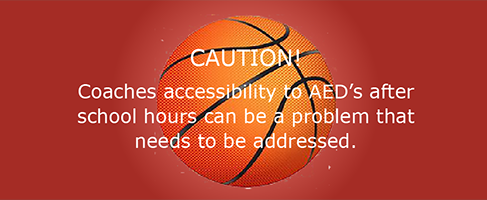

Concussions
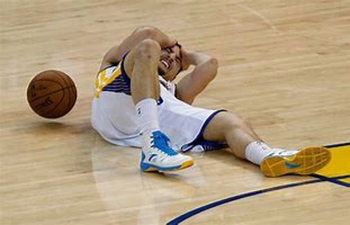
Recognize, respond to, and minimize the risk of concussion or other serious brain injury.
Choices made immediately after a concussion could mean the difference between recovery and permanent injury. Signs and symptoms normally show up along with the injury. However, the severity of the injury may not show up for hours or days later. Concussion are a type of traumatic brain injury that can have a serious effect on the brain. While most players with a concussion recover quickly and fully, some will have concussion symptoms that last for days, weeks, or even months. Recognizing and responding properly to concussions when they first occur can help prevent further injury or even death.
Signs & Symptoms
Loses consciousness. even briefly.
Appears dazed or stunned.
Moves clumsily or awkwardly.
Forgetfulness or trouble following instructions.
Unable to recall events.
Confused and answers questions slowly.Any signs or symptoms of concussion:
1. Remove player from game or practice immediately!
2. Inform parents or guardians.
3. Ensure that player is evaluated by a health care professional.
4. Obtain written permission to return play.
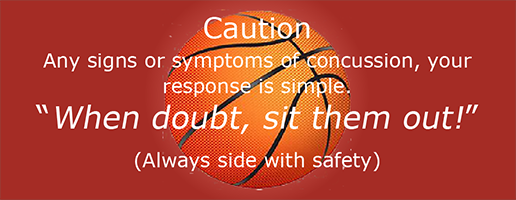

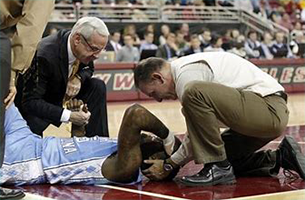
Head, Neck & Back injuries
Be extremely cautious when it comes to head, neck and back injuries. First aid: take all head, neck and back injuries seriously. Remove from practice or game immediately and seek medical advice. Requires doctor’s permission before returning to play.
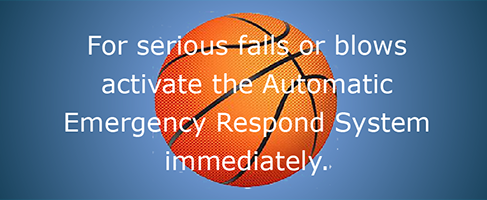
Any severe blow, fall, or other accident may result in injury to the neck, back, or spinal cord. Seek medical assistance immediately. Call for EMS. What to do until EMS arrives.
DO NOT move victim unless in a life threatening position.
Maintain position in which victim was found, even if neck or back is bent, and immobilize head, neck, shoulders, and torso by holding head.
Instruct the injured person to stay still, keep their head in line with their body. Immobilize by rolling up towels, or clothing, and place around head, neck, shoulders, and torso to prevent any side to side motion.

Heat Exhaustion & Heat Stroke
CAUTION
Coaches can also greatly contribute to player injuries and heat stroke by over-training players. Do not run a "Boot Camp" by pushing players too hard and running them into the ground the first few days of practice. This will only result in sore, achy muscles that will be detrimental and hinder player performance and learning over the next few weeks. Basketball conditioning is best done over a period time using full court drills. You want your team in the best physical shape at the end of the season when it counts, not the first week of practice.
Players can overheat by doing too much, too fast or enduring too long. Be vigilant for heavy sweating since it is a major symptom of heat exhaustion and early sign of heat stroke. Heat stroke is the third most common cause of death among athletes. Therefore, it is imperative to remove and immediately cool any player from competition or practice suspected of having any signs of heat exhaustion or stroke. Heat stroke has a 100% survival rate when a player is cooled down within the first ten minutes. However, the mortality rate increases tremendously with time. In just 30 to 40 minutes the survival rate is less than 40%.
With heat exhaustion, once cooled down and feeling better, players will want to resume play or practice. However, do not ever allow them to return. They are finished for the day since continue participation can result in life threating heat stroke.
Continue: Common Basketball Injuries Prevention & First Aid - Click Here
To return to Coaching Prerequisites - Click Here
To return to Coaching Strategies - Click Here
Return to HoopTactics' menu - Click Here
© 2026 HoopTactics All Rights Reserved.
